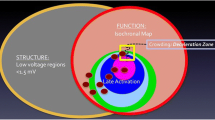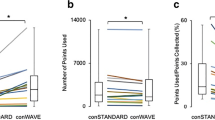Abstract
Purpose
Targets for substrate-based catheter ablation of scar-related ventricular tachycardia (VT) include sites with fractionated and late potentials (LPs). We hypothesized that in patients with cardiac resynchronization therapy (CRT), the pacing mode may influence the timing of abnormal electrograms (EGMs) relative to the surface QRS complex.
Methods
We assessed bipolar EGM characteristics in left ventricular low bipolar voltage areas (< 1.5 mV) from 10 patients with coronary disease and a CRT device undergoing catheter ablation for VT. EGMs at 81 sites were analyzed during three different pacing modes (biventricular (BiV), right ventricular (RV)-only, and left ventricular (LV)-only) pacing.
Results
Stimulus to end of local electrogram duration (Stim-to-eEGM) depended significantly on the stimulation site (BiV, LV, or RV, p = 0.032). Single-chamber pacing unmasked LPs, not present during BiV pacing, in three patients. In another three patients, a concomitant increase in stimulus to end of surface QRS duration caused by single-site pacing compensated for the increase in Stim-to-eEGM duration, thereby prohibiting LP unmasking.
Conclusion
The sequence of ventricular activation, as determined by the pacing site in patients with CRT devices, has a major influence on the detection of late potentials during substrate-guided ablation. Further study is warranted to define the optimal approaches, including the rhythm, for substrate mapping, but our findings suggest that BiV pacing may be most likely to obscure detection of late potentials as compared to single-site pacing.




Similar content being viewed by others
References
Poole JE, Johnson GW, Hellkamp AS, Anderson J, Callans DJ, Raitt MH, et al. Prognostic importance of defibrillator shocks in patients with heart failure. N Engl J Med. 2008;359(10):1009–17. https://doi.org/10.1056/NEJMoa071098.
Stevenson WG, Wilber DJ, Natale A, Jackman WM, Marchlinski FE, Talbert T, et al. Irrigated radiofrequency catheter ablation guided by electroanatomic mapping for recurrent ventricular tachycardia after myocardial infarction: the multicenter thermocool ventricular tachycardia ablation trial. Circulation. 2008;118(25):2773–82. https://doi.org/10.1161/CIRCULATIONAHA.108.788604.
Kuck KH, Schaumann A, Eckardt L, Willems S, Ventura R, Delacretaz E, et al. Catheter ablation of stable ventricular tachycardia before defibrillator implantation in patients with coronary heart disease (VTACH): a multicentre randomised controlled trial. Lancet. 2010;375(9708):31–40. https://doi.org/10.1016/S0140-6736(09)61755-4.
Carbucicchio C, Santamaria M, Trevisi N, Maccabelli G, Giraldi F, Fassini G, et al. Catheter ablation for the treatment of electrical storm in patients with implantable cardioverter-defibrillators: short- and long-term outcomes in a prospective single-center study. Circulation. 2008;117(4):462–9. https://doi.org/10.1161/CIRCULATIONAHA.106.686534.
Sapp JL, Wells GA, Parkash R, Stevenson WG, Blier L, Sarrazin JF, et al. Ventricular tachycardia ablation versus escalation of antiarrhythmic drugs. N Engl J Med. 2016;375(2):111–21. https://doi.org/10.1056/NEJMoa1513614.
Gardner PI, Ursell PC, Fenoglio JJ Jr, Wit AL. Electrophysiologic and anatomic basis for fractionated electrograms recorded from healed myocardial infarcts. Circulation. 1985;72(3):596–611.
Stevenson WG, Friedman PL, Sager PT, Saxon LA, Kocovic D, Harada T, et al. Exploring postinfarction reentrant ventricular tachycardia with entrainment mapping. J Am Coll Cardiol. 1997;29(6):1180–9.
Vergara P, Trevisi N, Ricco A, Petracca F, Baratto F, Cireddu M, et al. Late potentials abolition as an additional technique for reduction of arrhythmia recurrence in scar related ventricular tachycardia ablation. J Cardiovasc Electrophysiol. 2012;23(6):621–7. https://doi.org/10.1111/j.1540-8167.2011.02246.x.
Cassidy DM, Vassallo JA, Buxton AE, Doherty JU, Marchlinski FE, Josephson ME. The value of catheter mapping during sinus rhythm to localize site of origin of ventricular tachycardia. Circulation. 1984;69(6):1103–10.
Jais P, Maury P, Khairy P, Sacher F, Nault I, Komatsu Y, et al. Elimination of local abnormal ventricular activities: a new end point for substrate modification in patients with scar-related ventricular tachycardia. Circulation. 2012;125(18):2184–96. https://doi.org/10.1161/CIRCULATIONAHA.111.043216.
Jackson N, Gizurarson S, Viswanathan K, King B, Masse S, Kusha M, et al. Decrement evoked potential mapping: basis of a mechanistic strategy for ventricular tachycardia ablation. Circ Arrhythm Electrophysiol. 2015;8(6):1433–42. https://doi.org/10.1161/CIRCEP.115.003083.
Tung R, Josephson ME, Bradfield JS, Shivkumar K. Directional influences of ventricular activation on myocardial scar characterization: voltage mapping with multiple wavefronts during ventricular tachycardia ablation. Circ Arrhythm Electrophysiol. 2016;9(8):e004155. https://doi.org/10.1161/CIRCEP.116.004155.
Baldinger SH, Stevenson WG, John RM. Ablation of ischemic ventricular tachycardia: evidence, techniques, results, and future directions. Curr Opin Cardiol. 2016;31(1):29–36. https://doi.org/10.1097/HCO.0000000000000237.
Brunckhorst CB, Delacretaz E, Soejima K, Maisel WH, Friedman PL, Stevenson WG. Identification of the ventricular tachycardia isthmus after infarction by pace mapping. Circulation. 2004;110(6):652–9. https://doi.org/10.1161/01.CIR.0000138107.11518.AF.
Baldinger SH, Nagashima K, Kumar S, Barbhaiya CR, Choi EK, Epstein LM, et al. Electrogram analysis and pacing are complimentary for recognition of abnormal conduction and far-field potentials during substrate mapping of infarct-related ventricular tachycardia. Circ Arrhythm Electrophysiol. 2015;8(4):874–81. https://doi.org/10.1161/CIRCEP.114.002714.
de Bakker JM, Wittkampf FH. The pathophysiologic basis of fractionated and complex electrograms and the impact of recording techniques on their detection and interpretation. Circ Arrhythm Electrophysiol. 2010;3(2):204–13. https://doi.org/10.1161/CIRCEP.109.904763.
Funding
Dr. Baldinger received educational grants from the University Hospital of Bern, Switzerland, and the Swiss foundation for pacemakers and electrophysiology.
Dr. Epstein receives consulting fees from Boston Scientific, Medtronic, and Spectranetics. Dr. John receives consulting fees from St. Jude Medical. Dr. Michaud and Dr. Tedrow receive consulting fees from St. Jude Medical and research funding from Boston Scientific and Biosense Webster. Dr. Stevenson is co-holder of a patent for needle ablation that is consigned to Brigham and Women’s Hospital. Dr. Stevenson’s spouse receives research support from St. Jude Medical, Inc.
Author information
Authors and Affiliations
Contributions
Samuel H. Baldinger: concept/design, data analysis/interpretation, drafting of manuscript
Saurabh Kumar: concept/design, data collection, critical revision
Akira Fujii: data collection, critical revision
Andreas Haeberlin: statistics, critical revision
Jorge Romero: critical revision
Laurence M. Epstein: critical revision
Gregory F. Michaud: critical revision
Roy John: critical revision
Usha B. Tedrow: critical revision
William G. Stevenson: concept/design, data interpretation, critical revision
Corresponding author
Ethics declarations
Data collection was performed according to protocols approved by the Human Research Committee of Brigham and Women’s Hospital. Each patient gave written informed consent for the electrophysiology procedure.
Additional information
Publisher’s note
Springer Nature remains neutral with regard to jurisdictional claims in published maps and institutional affiliations.
Rights and permissions
About this article
Cite this article
Baldinger, S.H., Kumar, S., Fujii, A. et al. Substrate mapping for scar-related ventricular tachycardia in patients with resynchronization therapy—the importance of the pacing mode. J Interv Card Electrophysiol 55, 55–62 (2019). https://doi.org/10.1007/s10840-019-00548-5
Received:
Accepted:
Published:
Issue Date:
DOI: https://doi.org/10.1007/s10840-019-00548-5




